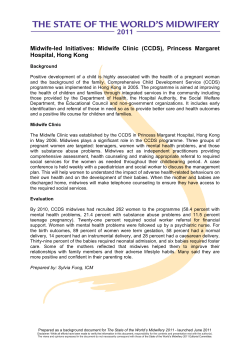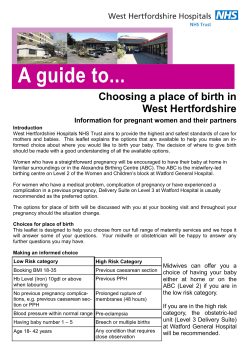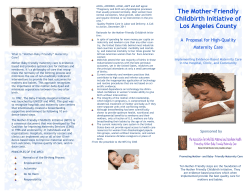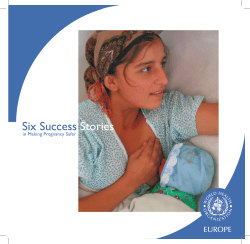
Maternity care in Norway Bjørn Backe Professor MD PhD NTNU
Maternity care in Norway Bjørn Backe Professor MD PhD NTNU and National Advisory Committee for Obstetrics 1 Parliament decisions on delivery units - changes in organizing obstetric care in Norway Pål Øian Department of Obstetrics and Gynaecology University of Tromsø 2 Contents: History & recent development: 1. 2. 3. Midwifery in Norway Antenatal care Obstetrical care – – – 3 Differentiated Decentralized Continuity of care (same care provider throughout) 4 Midwifery in Norway (I) • • • • 1814: 54 midwives in Norway (+ a few Danish) 1818: School of Midwifery in Kristiania (Oslo) 1861: School of Midwifery in Bergen 1889: Midwifery Law – District midwives – Public employed – Monopoly – Mandatory to use midwife services • No of District midwives, 1950: 1400, 1970: 250 5 Midwifery in Norway (II) • Up to 1940 Home delivery was the rule – (1950: 25 % home deliveries) • From ~1940 – obstetrical care institutionalized – Hospital deliveries in local hospitals – Rural maternity units (Fødestuer – ”cottage hospitals”) • Community, charity organisations etc. • Staffed by District Midwives • 1990 District midwife system was terminated – From 1990: Community midwives 6 Midwives and doctors in Norway 1900-2000 16000 14000 12000 10000 Midw Doct 8000 6000 4000 2000 0 1900 1910 1920 1930 1940 1950 1960 1970 1980 1990 2000 7 (Source: Statistics Norway) Norwegian midwives are • (Usually) Public employed – Communities or – (public) hospital owners • Autonomous profession – Midwives (and nurses) are not doctors’ assistants • Manage normal vaginal deliveries – Authorized to handle deliveries and – Authorized to decide when they need help 8 Antenatal Care in Norway 9 Short History of ANC in Norway (I) • Frequent urine testing in pregnancy for protein recommended in articles (1904) and text books (1913) • Organized care introduced 1938 as part of community based primary health care – Stortinget 1934 voted for a Swedish/Danish/Finnish system, the administration did not comply because of the costs – Medical association (pediatricians) intervened 1938 and GPs was involved • 1947: Syphilis testing of pregnant women mandatory – ANC became ”mandatory” 10 Short history of ANC in Norway (II) • ANC was provided by the GPs and District Midwives were usually not involved in ANC • 1976: Stortinget stated that ANC should be provided by midwives (nothing happened) • ~1984: Public debate about quality of ANC/ higher stillborn rates in N than in S and Dk 11 Perinatal mortality in Denmark, Finland, Norway and Sweden 1951-1979 (Larssen KE, Bakketeig LS, Bergsjø P, Finne PH: Perinatal service in Norway during the 1970s. 12 NIS report 6/81) Perinatal audit 1980 – 30 % avoidable deaths 13 Quality problem in perinatal care – Official report 1984, remedial actions: • • • • • • • • 14 Routine audit of deaths Guidelines for ANC Midwives should be involved in ANC Guidelines for equipment and transfer of newborns Plans for education and post graduate education Etc. Midwives in ANC – slow process • 1984: Official report recommended that midwives should do ANC • 1990: Community health care act midwife recommendation • 1995: Community health care act instructed communities to provide midwife services • 2000: Midwives provide ~50 % of ANC visits (Backe 2002) – Midwives in all communities (~450) 15 New guidelines for ANC (2005) • • • • • • 16 Evidence based Fewer controls Less medicalization? Less rituals Midwives or GPs Continuity of care advocated 17 Obstetrical care in Norway • Has always been Decentralized • And Always Midwife Based • But No continuity of care – ANC provided by GP – Midwives delivered and provided care after delivery – Community health nurses followed up 18 Obstetrical units by number of births 9000 8000 7000 6000 5000 4000 3000 2000 1000 0 No of births Danmark Sweden Norway 1 2 3 No of institutions 19 4 5 Distribution of Births in the Nordic Countries by Size of Obstetric Unit Norway (n=61.307) Sweden (n=88.837) Finland (n=59.567) Denmark (n=62.262) Total no of institutions 62 52 44 50 No of units with < 500 deliveries per year 30 7 12 9 11.1 % 2.4 % 6.4 % 3.7 % % of deliveries in units with < 500 20 deliveries per year Problems with maternity services in rural areas: • Debate on quality of care in small obstetrical units • Recruitment problems in small units • Problems caused by temporary staff • “Centralization! Like Sweden!” – Births are unpredictable – Units are too small – Surgeons leave obstetrics Standard textbook 2004 21 “Professional requirements for birth institutions.” Norwegian Directorate of Health 1997 • Level 1 – Maternity homes (Midwives, selected low risk) – At least 40 deliveries per year • Level 2 – Obstetrical departments (+ OBGYN & anesthesiologists, pediatrician available) – At least 4-500 deliveries per year • 22 Level 3 – “Kvinneklinikk” - at least 1.500 deliveries per year (+ NICU) Lofoten project 1997-98 • Small obstetric department reorganized as midwife-based obstetric unit • Heavy protests from – Public – Doctors – Midwives 23 Lofot-project 1997-1998 * “Uptake rate” reduced from 90 % to 70 % * No perinatal deaths attributable to the reorganization * Obstetrician/surgeon on call contacted 30 (1997) and 38 (1998) times annually * 29 women transferred during labor (6 %) * No transport deliveries during transfer * CS rate 4.3 % and 1.8 % * CS rate in the population reduced from 15.8 % to 11.8 % Vold IN, Holt J, Johansen MV, Backe B, Øian P. Modifisert fødestuedrift - et alternativ for små fødeavdelinger? Tidsskr Nor Lægeforen 2001; 121: 941-5. 24 Holt J, Vold IN, Backe B, Johansen MV, Øian P. Child births in a modified midwife managed unit: Selection and transfer according to intended place of delivery. Acta Obstet Gynecol Scand 2001, 80: 206-12 Lay-women conference 1999 Conference on obstetrics in rural areas 2000 • • • • 25 Decentralised Continuity of care Midwives involved in ANC Obstetrical care differentiated according to risk Health Directorate and National Research Council Parliament resolutions (2001) 26 • Obsterical Care must be Decentralized • And Differentiated According to Risk • The Professional requirements (1997) must be followed • A National Advisory Committee for Obstetrics should be appointed to assist hospital owners in the reorganization of obstetrical services Obstetrical institutions, Norway 1974-2005 1974 1980 1990 1999 2005 Cottage hospital 59 30 18 9 10 Maternity home 2 1 Dept of obst (surgeon) 39 33 7 1 Dept of obst (gyn) 31 33 46 45 42 2 5 57 57 Midwife obst unit in local hospital Sum 27 131 97 71 Parliament resolutions: Implications • Small obstetrical departments (< 400 deliveries per year) must be converted to maternity homes – about 50 % of obstetrical units in Norway! • All obstetrical departments must distinguish between normal pregnant women and high-risk patients – ABC units – Green and red women 28 Births in Region North • • • • • 29 18 birth institutions: 3 hospitals 9 hospitals 6 cottage hospitals During transport: Total 6.000 deliveries > 400 deliveries < 400 deliveries 550 deliveries 40 deliveries National advisory Committee for Obstetrics • • • • • • • • 30 Stine Bernitz Nina Schmidt Atle Klovning Torunn Eikeland Bjørn Backe Steinar Pleym Pedersen Pål Øian Sølvi Taraldsen Midwife, Fredrikstad Midwife, Alta General practitioneer, Bergen OBGYN, Haugesund OBGYN, Trondheim Hospital director, Lofoten OBGYN (head), Tromsø OBGYN (secretary), Directorate for Health and Social affairs, Oslo Parliament resolution of 2001 is a crossroad • A revolution is taking place in Norwegian obstetrics • The Parliament decisions are fair and evidence-based • We are moving in the direction recommended by WHO (Safe Motherhood 1996) 31 “So where then should a woman give birth?” “.. in a place she feels is safe ... For a low-risk pregnant woman, this can be at home, at a small maternity clinic or birth centre in town or perhaps at the maternity unit of a larger hospital.” (WHO Safe Motherhood 1996, p 12) 32 33
© Copyright 2025





















